USA Health Intervention: Combating Physical Inactivity in Children
VerifiedAdded on 2023/04/23
|18
|4595
|322
Report
AI Summary
This report analyzes the problem of physical inactivity among children in the USA and proposes a health improvement intervention plan. The report identifies the causes, risks, and consequences of physical inactivity, including rising obesity rates and associated health issues like type 2 diabetes and heart disease, costing the US economy billions. It focuses on sub-populations of children aged 0-5, 6-11, and 12-19 years. The report then explores three theory-based solutions: policy development, competitive programs, and public health campaigns. It recommends implementing a competitive program, supported by behavioral change models and the RE-AIM framework, to effectively promote physical activity among children and improve their overall health and well-being. Desklib provides similar solved assignments and past papers for students.
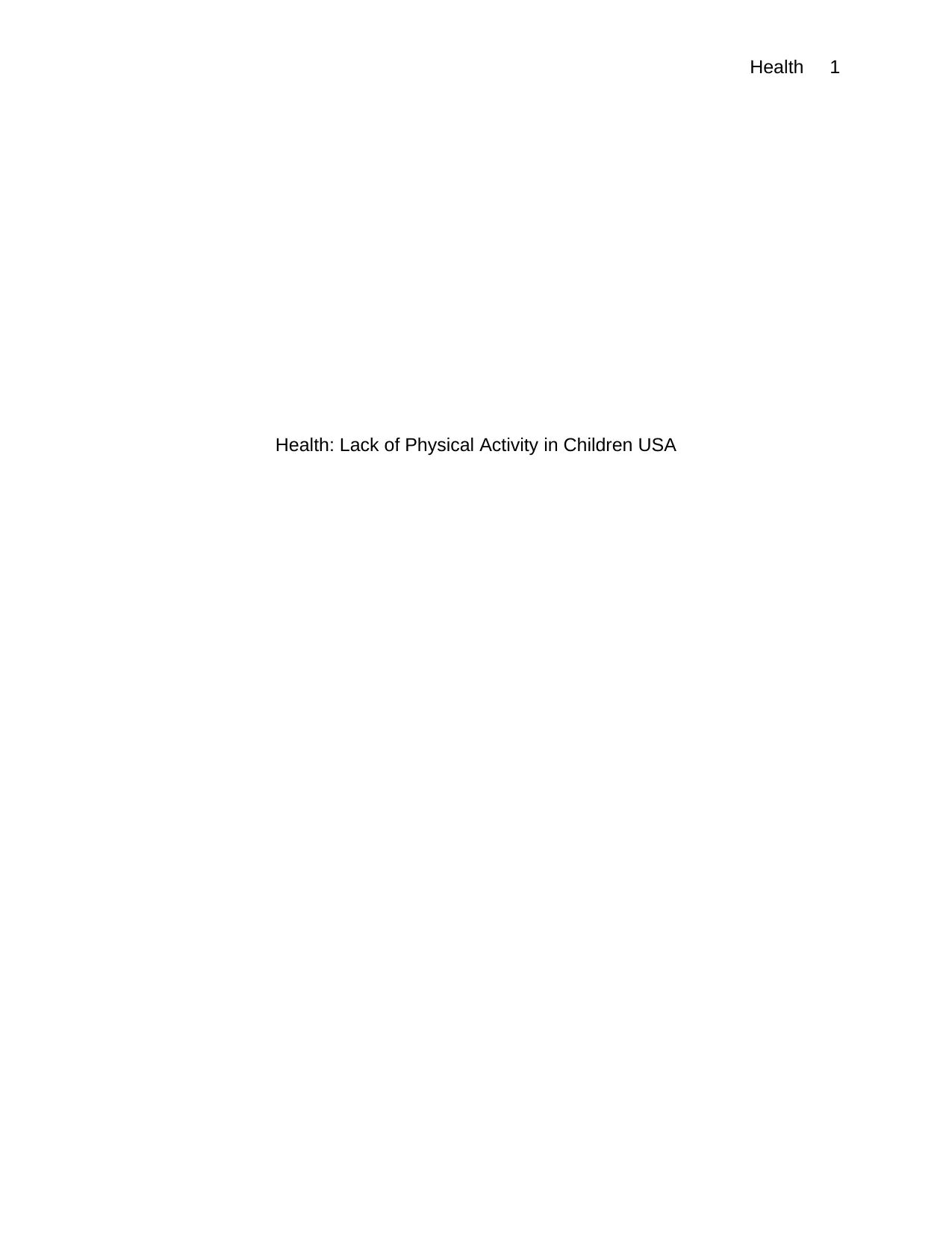
Health 1
Health: Lack of Physical Activity in Children USA
Health: Lack of Physical Activity in Children USA
Paraphrase This Document
Need a fresh take? Get an instant paraphrase of this document with our AI Paraphraser
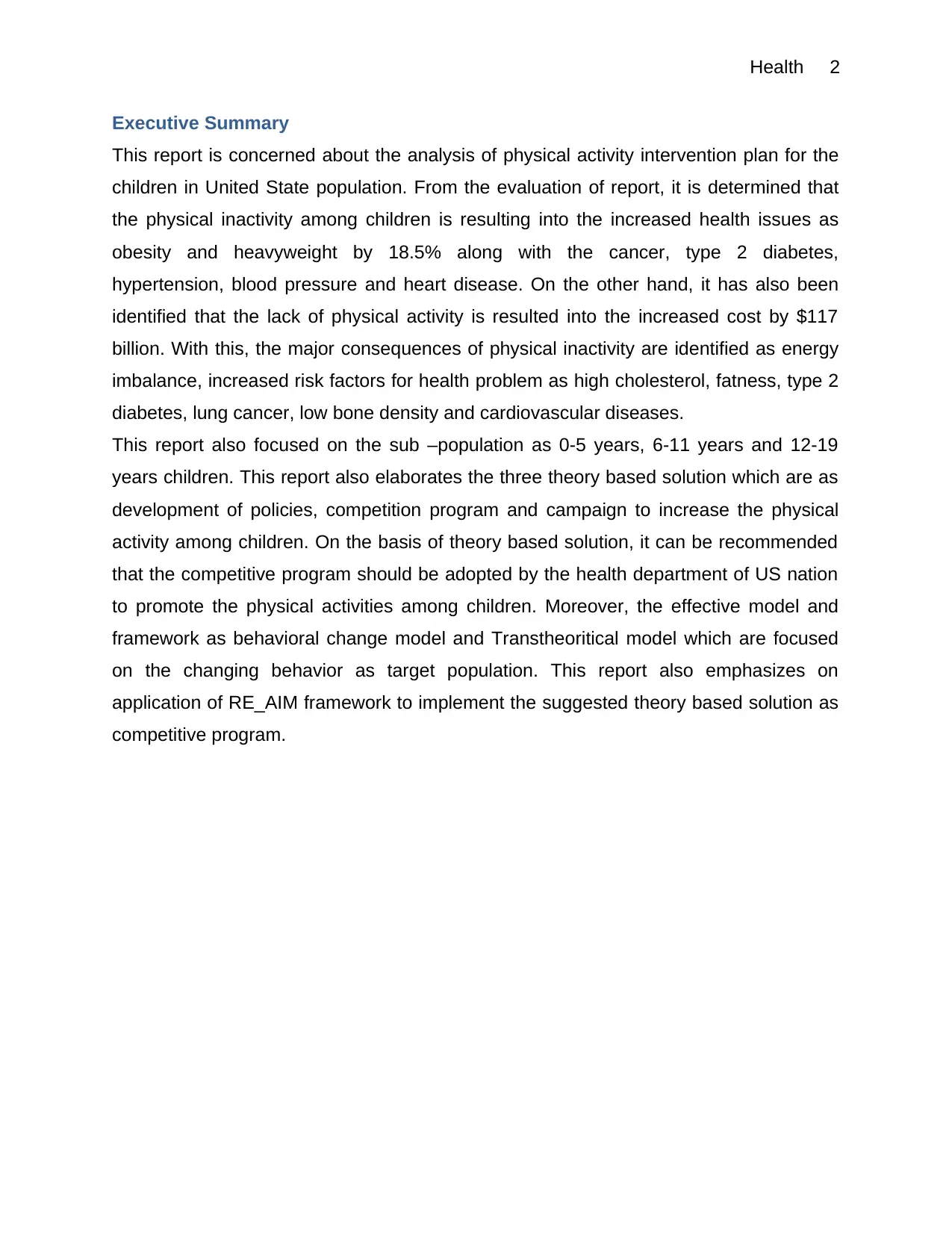
Health 2
Executive Summary
This report is concerned about the analysis of physical activity intervention plan for the
children in United State population. From the evaluation of report, it is determined that
the physical inactivity among children is resulting into the increased health issues as
obesity and heavyweight by 18.5% along with the cancer, type 2 diabetes,
hypertension, blood pressure and heart disease. On the other hand, it has also been
identified that the lack of physical activity is resulted into the increased cost by $117
billion. With this, the major consequences of physical inactivity are identified as energy
imbalance, increased risk factors for health problem as high cholesterol, fatness, type 2
diabetes, lung cancer, low bone density and cardiovascular diseases.
This report also focused on the sub –population as 0-5 years, 6-11 years and 12-19
years children. This report also elaborates the three theory based solution which are as
development of policies, competition program and campaign to increase the physical
activity among children. On the basis of theory based solution, it can be recommended
that the competitive program should be adopted by the health department of US nation
to promote the physical activities among children. Moreover, the effective model and
framework as behavioral change model and Transtheoritical model which are focused
on the changing behavior as target population. This report also emphasizes on
application of RE_AIM framework to implement the suggested theory based solution as
competitive program.
Executive Summary
This report is concerned about the analysis of physical activity intervention plan for the
children in United State population. From the evaluation of report, it is determined that
the physical inactivity among children is resulting into the increased health issues as
obesity and heavyweight by 18.5% along with the cancer, type 2 diabetes,
hypertension, blood pressure and heart disease. On the other hand, it has also been
identified that the lack of physical activity is resulted into the increased cost by $117
billion. With this, the major consequences of physical inactivity are identified as energy
imbalance, increased risk factors for health problem as high cholesterol, fatness, type 2
diabetes, lung cancer, low bone density and cardiovascular diseases.
This report also focused on the sub –population as 0-5 years, 6-11 years and 12-19
years children. This report also elaborates the three theory based solution which are as
development of policies, competition program and campaign to increase the physical
activity among children. On the basis of theory based solution, it can be recommended
that the competitive program should be adopted by the health department of US nation
to promote the physical activities among children. Moreover, the effective model and
framework as behavioral change model and Transtheoritical model which are focused
on the changing behavior as target population. This report also emphasizes on
application of RE_AIM framework to implement the suggested theory based solution as
competitive program.
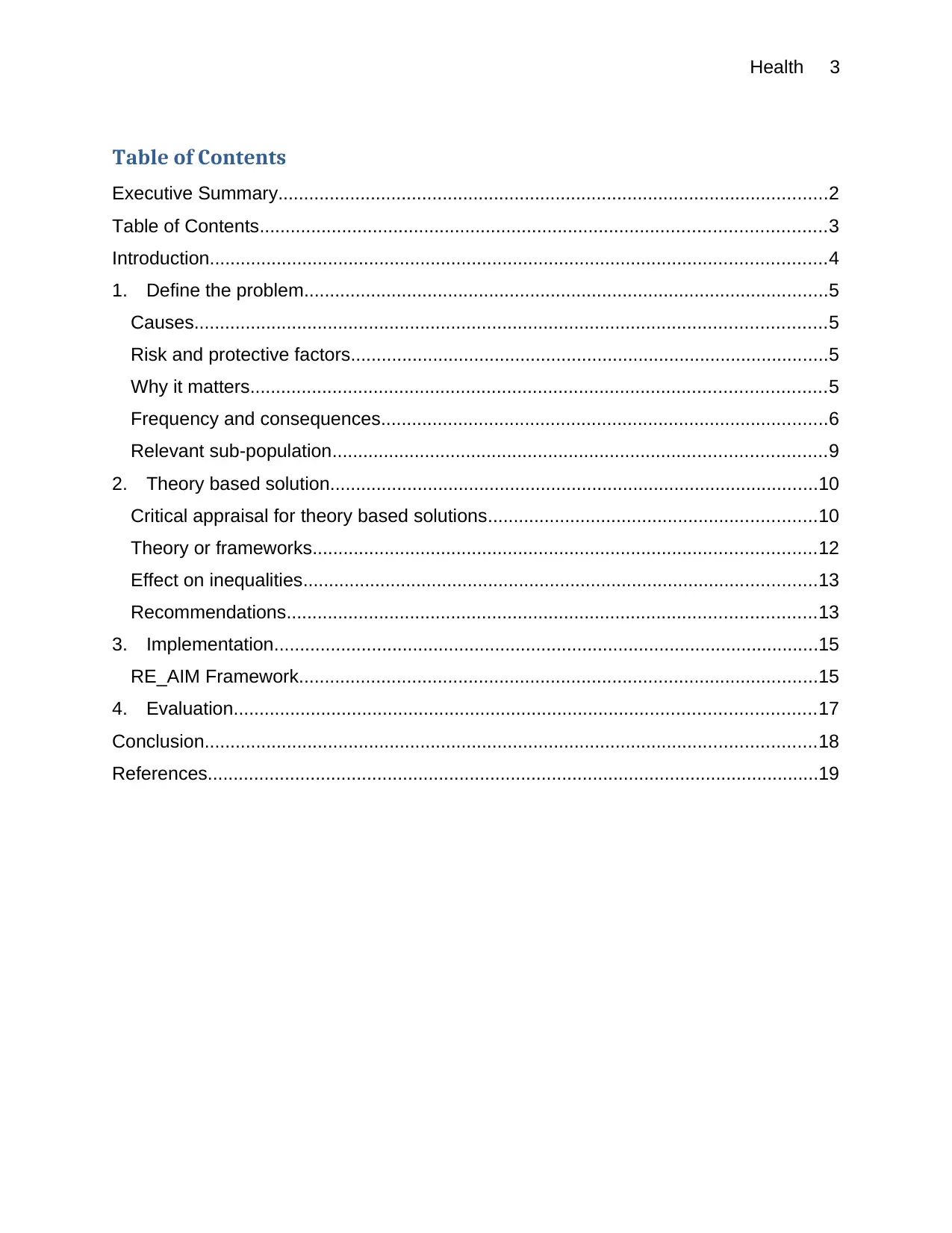
Health 3
Table of Contents
Executive Summary...........................................................................................................2
Table of Contents..............................................................................................................3
Introduction........................................................................................................................4
1. Define the problem......................................................................................................5
Causes...........................................................................................................................5
Risk and protective factors.............................................................................................5
Why it matters................................................................................................................5
Frequency and consequences.......................................................................................6
Relevant sub-population................................................................................................9
2. Theory based solution...............................................................................................10
Critical appraisal for theory based solutions................................................................10
Theory or frameworks..................................................................................................12
Effect on inequalities....................................................................................................13
Recommendations.......................................................................................................13
3. Implementation..........................................................................................................15
RE_AIM Framework.....................................................................................................15
4. Evaluation.................................................................................................................17
Conclusion.......................................................................................................................18
References.......................................................................................................................19
Table of Contents
Executive Summary...........................................................................................................2
Table of Contents..............................................................................................................3
Introduction........................................................................................................................4
1. Define the problem......................................................................................................5
Causes...........................................................................................................................5
Risk and protective factors.............................................................................................5
Why it matters................................................................................................................5
Frequency and consequences.......................................................................................6
Relevant sub-population................................................................................................9
2. Theory based solution...............................................................................................10
Critical appraisal for theory based solutions................................................................10
Theory or frameworks..................................................................................................12
Effect on inequalities....................................................................................................13
Recommendations.......................................................................................................13
3. Implementation..........................................................................................................15
RE_AIM Framework.....................................................................................................15
4. Evaluation.................................................................................................................17
Conclusion.......................................................................................................................18
References.......................................................................................................................19
⊘ This is a preview!⊘
Do you want full access?
Subscribe today to unlock all pages.

Trusted by 1+ million students worldwide
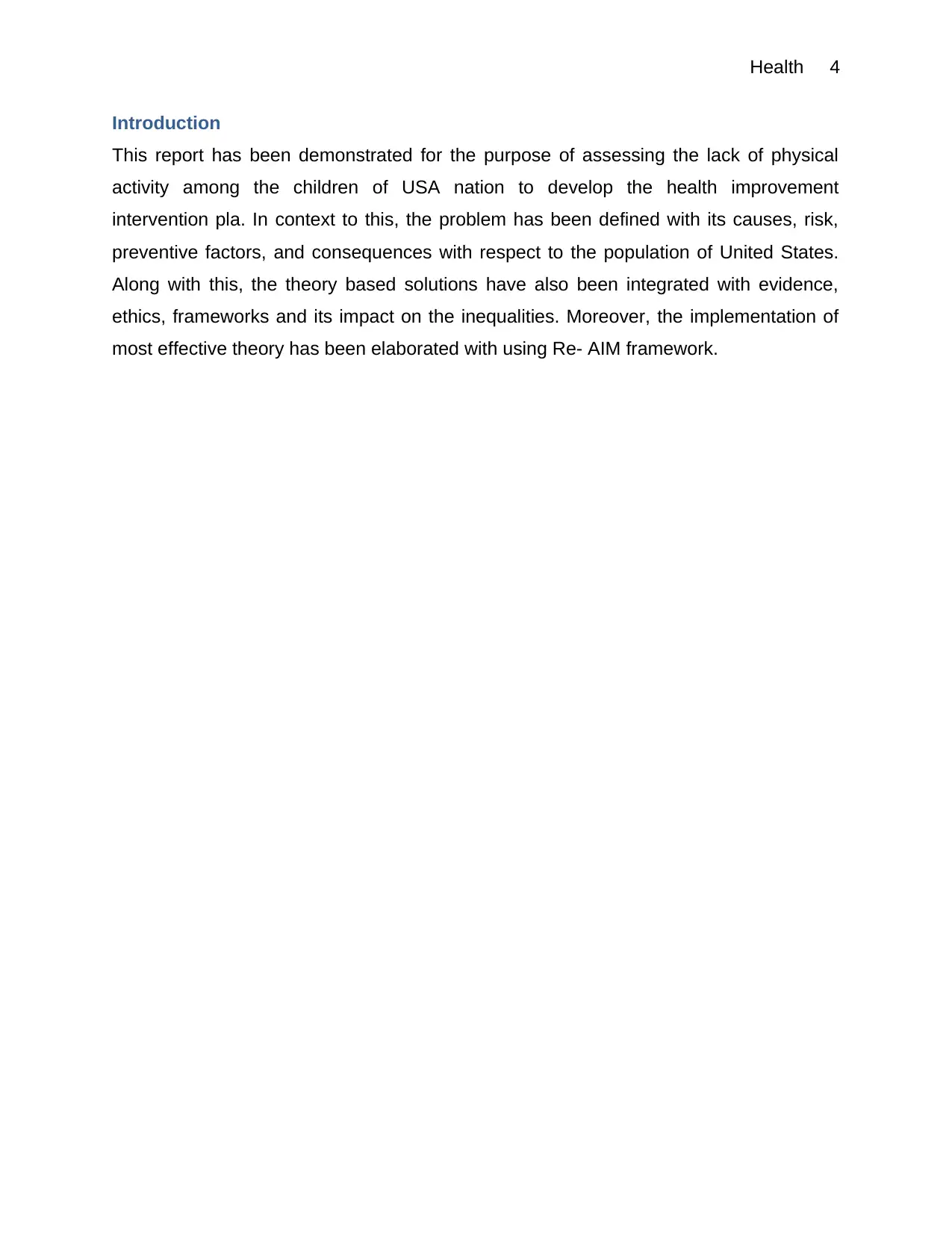
Health 4
Introduction
This report has been demonstrated for the purpose of assessing the lack of physical
activity among the children of USA nation to develop the health improvement
intervention pla. In context to this, the problem has been defined with its causes, risk,
preventive factors, and consequences with respect to the population of United States.
Along with this, the theory based solutions have also been integrated with evidence,
ethics, frameworks and its impact on the inequalities. Moreover, the implementation of
most effective theory has been elaborated with using Re- AIM framework.
Introduction
This report has been demonstrated for the purpose of assessing the lack of physical
activity among the children of USA nation to develop the health improvement
intervention pla. In context to this, the problem has been defined with its causes, risk,
preventive factors, and consequences with respect to the population of United States.
Along with this, the theory based solutions have also been integrated with evidence,
ethics, frameworks and its impact on the inequalities. Moreover, the implementation of
most effective theory has been elaborated with using Re- AIM framework.
Paraphrase This Document
Need a fresh take? Get an instant paraphrase of this document with our AI Paraphraser
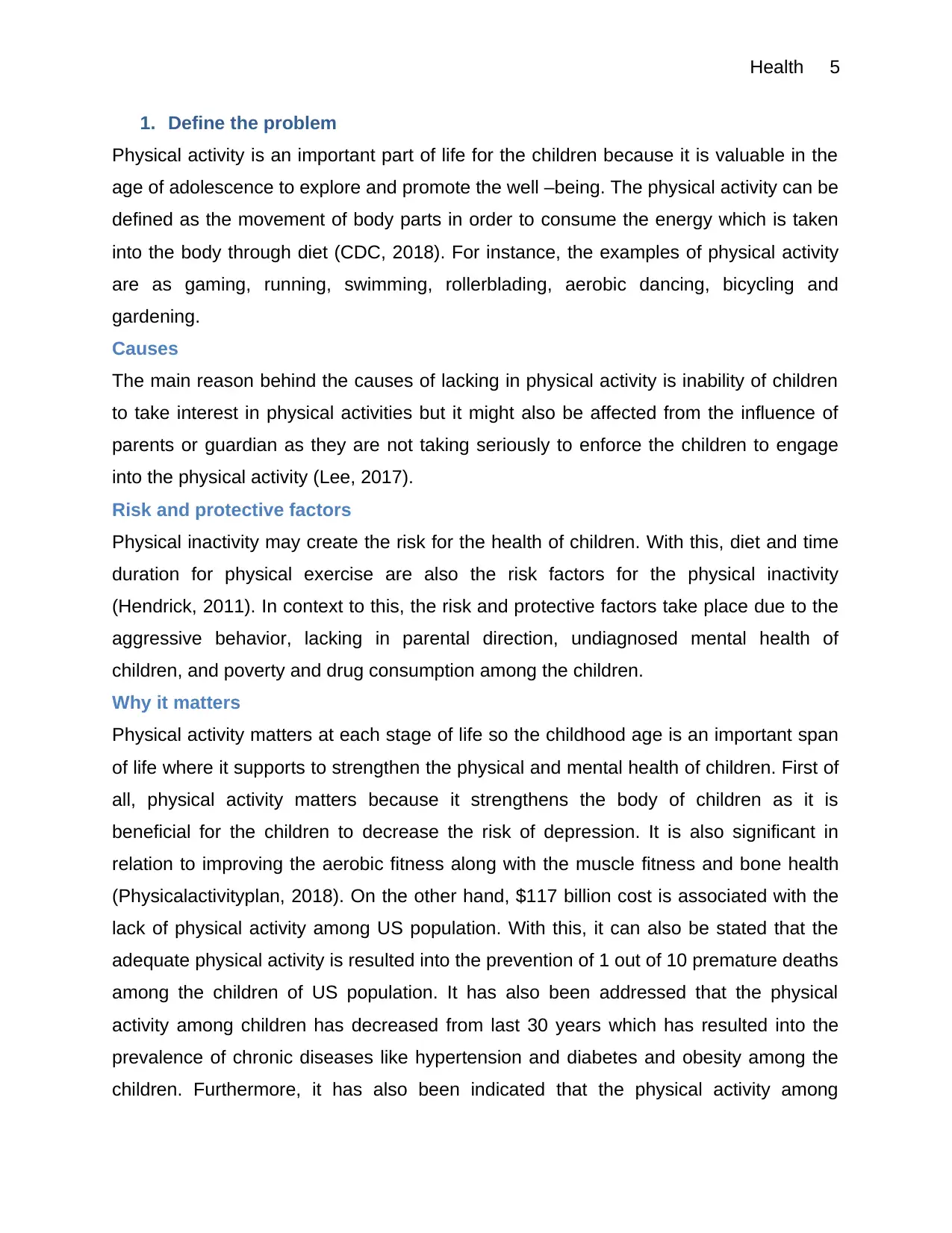
Health 5
1. Define the problem
Physical activity is an important part of life for the children because it is valuable in the
age of adolescence to explore and promote the well –being. The physical activity can be
defined as the movement of body parts in order to consume the energy which is taken
into the body through diet (CDC, 2018). For instance, the examples of physical activity
are as gaming, running, swimming, rollerblading, aerobic dancing, bicycling and
gardening.
Causes
The main reason behind the causes of lacking in physical activity is inability of children
to take interest in physical activities but it might also be affected from the influence of
parents or guardian as they are not taking seriously to enforce the children to engage
into the physical activity (Lee, 2017).
Risk and protective factors
Physical inactivity may create the risk for the health of children. With this, diet and time
duration for physical exercise are also the risk factors for the physical inactivity
(Hendrick, 2011). In context to this, the risk and protective factors take place due to the
aggressive behavior, lacking in parental direction, undiagnosed mental health of
children, and poverty and drug consumption among the children.
Why it matters
Physical activity matters at each stage of life so the childhood age is an important span
of life where it supports to strengthen the physical and mental health of children. First of
all, physical activity matters because it strengthens the body of children as it is
beneficial for the children to decrease the risk of depression. It is also significant in
relation to improving the aerobic fitness along with the muscle fitness and bone health
(Physicalactivityplan, 2018). On the other hand, $117 billion cost is associated with the
lack of physical activity among US population. With this, it can also be stated that the
adequate physical activity is resulted into the prevention of 1 out of 10 premature deaths
among the children of US population. It has also been addressed that the physical
activity among children has decreased from last 30 years which has resulted into the
prevalence of chronic diseases like hypertension and diabetes and obesity among the
children. Furthermore, it has also been indicated that the physical activity among
1. Define the problem
Physical activity is an important part of life for the children because it is valuable in the
age of adolescence to explore and promote the well –being. The physical activity can be
defined as the movement of body parts in order to consume the energy which is taken
into the body through diet (CDC, 2018). For instance, the examples of physical activity
are as gaming, running, swimming, rollerblading, aerobic dancing, bicycling and
gardening.
Causes
The main reason behind the causes of lacking in physical activity is inability of children
to take interest in physical activities but it might also be affected from the influence of
parents or guardian as they are not taking seriously to enforce the children to engage
into the physical activity (Lee, 2017).
Risk and protective factors
Physical inactivity may create the risk for the health of children. With this, diet and time
duration for physical exercise are also the risk factors for the physical inactivity
(Hendrick, 2011). In context to this, the risk and protective factors take place due to the
aggressive behavior, lacking in parental direction, undiagnosed mental health of
children, and poverty and drug consumption among the children.
Why it matters
Physical activity matters at each stage of life so the childhood age is an important span
of life where it supports to strengthen the physical and mental health of children. First of
all, physical activity matters because it strengthens the body of children as it is
beneficial for the children to decrease the risk of depression. It is also significant in
relation to improving the aerobic fitness along with the muscle fitness and bone health
(Physicalactivityplan, 2018). On the other hand, $117 billion cost is associated with the
lack of physical activity among US population. With this, it can also be stated that the
adequate physical activity is resulted into the prevention of 1 out of 10 premature deaths
among the children of US population. It has also been addressed that the physical
activity among children has decreased from last 30 years which has resulted into the
prevalence of chronic diseases like hypertension and diabetes and obesity among the
children. Furthermore, it has also been indicated that the physical activity among
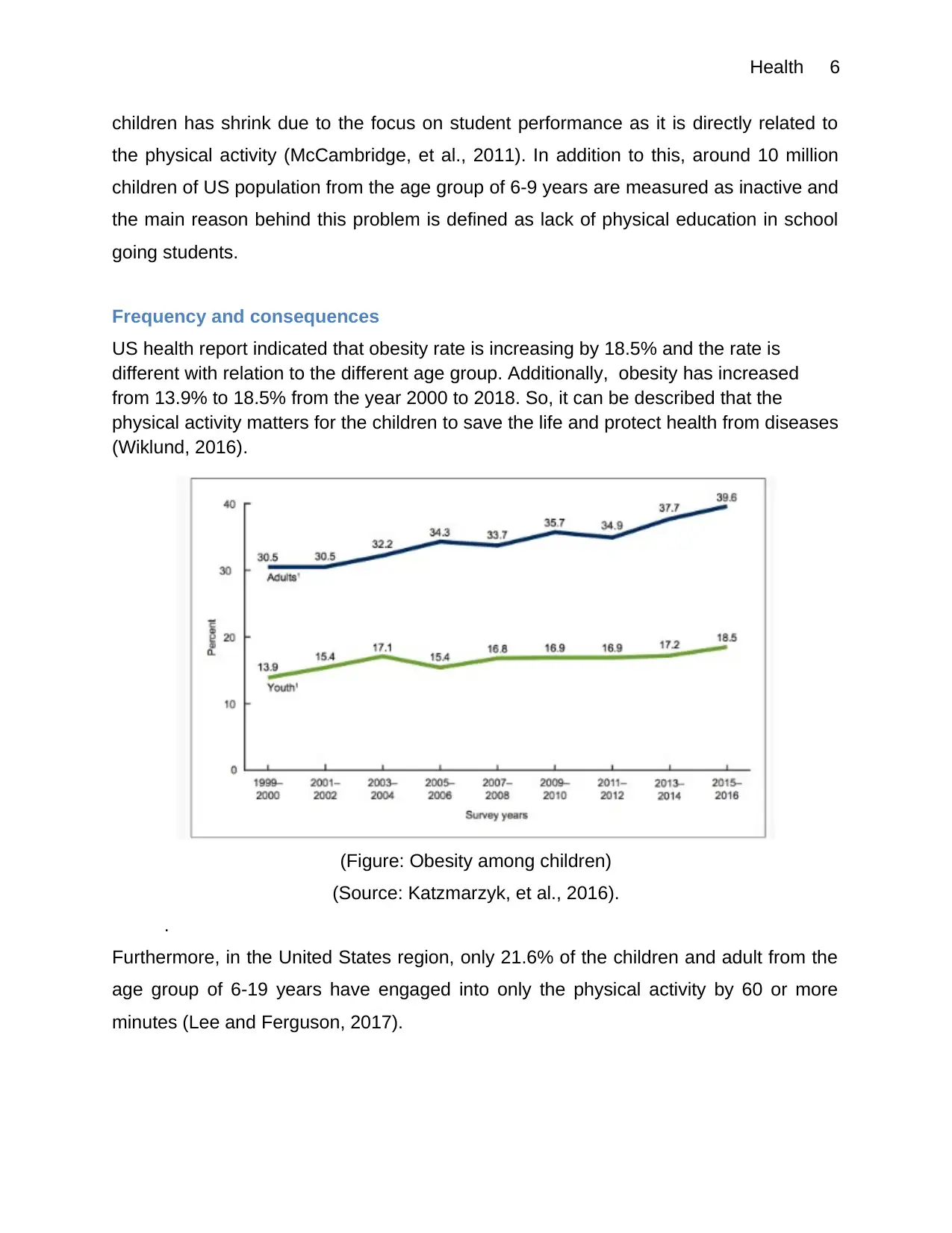
Health 6
children has shrink due to the focus on student performance as it is directly related to
the physical activity (McCambridge, et al., 2011). In addition to this, around 10 million
children of US population from the age group of 6-9 years are measured as inactive and
the main reason behind this problem is defined as lack of physical education in school
going students.
Frequency and consequences
US health report indicated that obesity rate is increasing by 18.5% and the rate is
different with relation to the different age group. Additionally, obesity has increased
from 13.9% to 18.5% from the year 2000 to 2018. So, it can be described that the
physical activity matters for the children to save the life and protect health from diseases
(Wiklund, 2016).
(Figure: Obesity among children)
(Source: Katzmarzyk, et al., 2016).
.
Furthermore, in the United States region, only 21.6% of the children and adult from the
age group of 6-19 years have engaged into only the physical activity by 60 or more
minutes (Lee and Ferguson, 2017).
children has shrink due to the focus on student performance as it is directly related to
the physical activity (McCambridge, et al., 2011). In addition to this, around 10 million
children of US population from the age group of 6-9 years are measured as inactive and
the main reason behind this problem is defined as lack of physical education in school
going students.
Frequency and consequences
US health report indicated that obesity rate is increasing by 18.5% and the rate is
different with relation to the different age group. Additionally, obesity has increased
from 13.9% to 18.5% from the year 2000 to 2018. So, it can be described that the
physical activity matters for the children to save the life and protect health from diseases
(Wiklund, 2016).
(Figure: Obesity among children)
(Source: Katzmarzyk, et al., 2016).
.
Furthermore, in the United States region, only 21.6% of the children and adult from the
age group of 6-19 years have engaged into only the physical activity by 60 or more
minutes (Lee and Ferguson, 2017).
⊘ This is a preview!⊘
Do you want full access?
Subscribe today to unlock all pages.

Trusted by 1+ million students worldwide
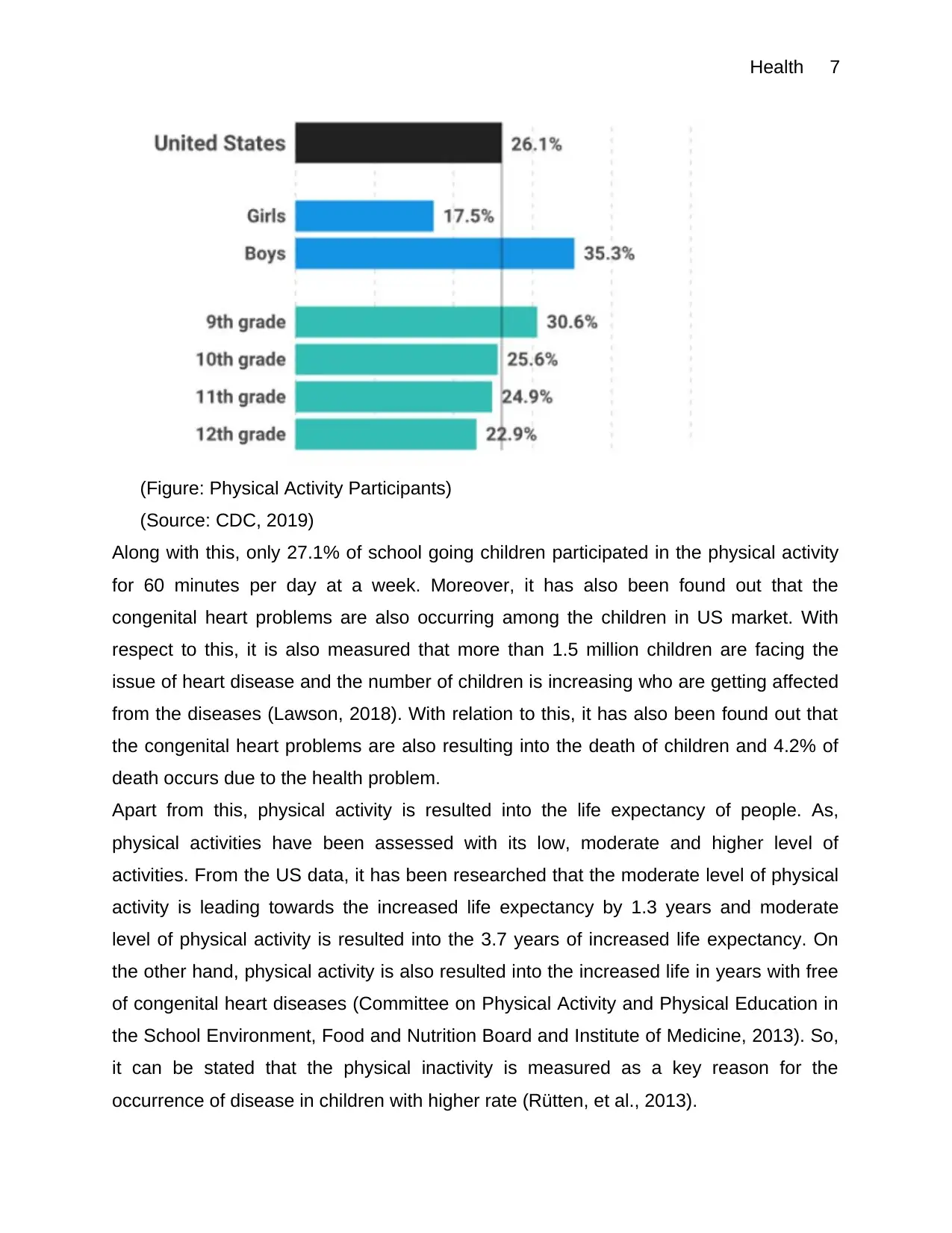
Health 7
(Figure: Physical Activity Participants)
(Source: CDC, 2019)
Along with this, only 27.1% of school going children participated in the physical activity
for 60 minutes per day at a week. Moreover, it has also been found out that the
congenital heart problems are also occurring among the children in US market. With
respect to this, it is also measured that more than 1.5 million children are facing the
issue of heart disease and the number of children is increasing who are getting affected
from the diseases (Lawson, 2018). With relation to this, it has also been found out that
the congenital heart problems are also resulting into the death of children and 4.2% of
death occurs due to the health problem.
Apart from this, physical activity is resulted into the life expectancy of people. As,
physical activities have been assessed with its low, moderate and higher level of
activities. From the US data, it has been researched that the moderate level of physical
activity is leading towards the increased life expectancy by 1.3 years and moderate
level of physical activity is resulted into the 3.7 years of increased life expectancy. On
the other hand, physical activity is also resulted into the increased life in years with free
of congenital heart diseases (Committee on Physical Activity and Physical Education in
the School Environment, Food and Nutrition Board and Institute of Medicine, 2013). So,
it can be stated that the physical inactivity is measured as a key reason for the
occurrence of disease in children with higher rate (Rütten, et al., 2013).
(Figure: Physical Activity Participants)
(Source: CDC, 2019)
Along with this, only 27.1% of school going children participated in the physical activity
for 60 minutes per day at a week. Moreover, it has also been found out that the
congenital heart problems are also occurring among the children in US market. With
respect to this, it is also measured that more than 1.5 million children are facing the
issue of heart disease and the number of children is increasing who are getting affected
from the diseases (Lawson, 2018). With relation to this, it has also been found out that
the congenital heart problems are also resulting into the death of children and 4.2% of
death occurs due to the health problem.
Apart from this, physical activity is resulted into the life expectancy of people. As,
physical activities have been assessed with its low, moderate and higher level of
activities. From the US data, it has been researched that the moderate level of physical
activity is leading towards the increased life expectancy by 1.3 years and moderate
level of physical activity is resulted into the 3.7 years of increased life expectancy. On
the other hand, physical activity is also resulted into the increased life in years with free
of congenital heart diseases (Committee on Physical Activity and Physical Education in
the School Environment, Food and Nutrition Board and Institute of Medicine, 2013). So,
it can be stated that the physical inactivity is measured as a key reason for the
occurrence of disease in children with higher rate (Rütten, et al., 2013).
Paraphrase This Document
Need a fresh take? Get an instant paraphrase of this document with our AI Paraphraser
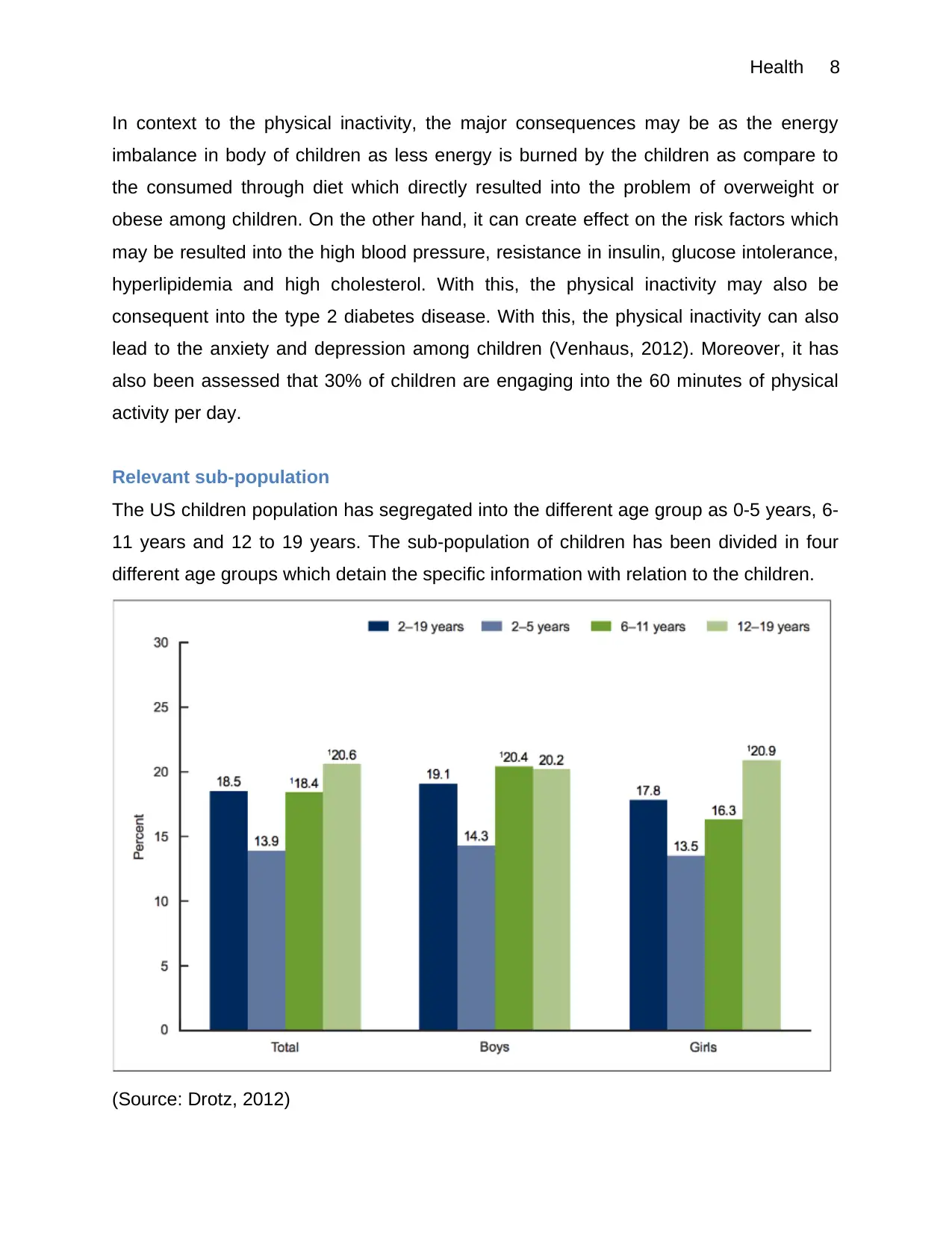
Health 8
In context to the physical inactivity, the major consequences may be as the energy
imbalance in body of children as less energy is burned by the children as compare to
the consumed through diet which directly resulted into the problem of overweight or
obese among children. On the other hand, it can create effect on the risk factors which
may be resulted into the high blood pressure, resistance in insulin, glucose intolerance,
hyperlipidemia and high cholesterol. With this, the physical inactivity may also be
consequent into the type 2 diabetes disease. With this, the physical inactivity can also
lead to the anxiety and depression among children (Venhaus, 2012). Moreover, it has
also been assessed that 30% of children are engaging into the 60 minutes of physical
activity per day.
Relevant sub-population
The US children population has segregated into the different age group as 0-5 years, 6-
11 years and 12 to 19 years. The sub-population of children has been divided in four
different age groups which detain the specific information with relation to the children.
(Source: Drotz, 2012)
In context to the physical inactivity, the major consequences may be as the energy
imbalance in body of children as less energy is burned by the children as compare to
the consumed through diet which directly resulted into the problem of overweight or
obese among children. On the other hand, it can create effect on the risk factors which
may be resulted into the high blood pressure, resistance in insulin, glucose intolerance,
hyperlipidemia and high cholesterol. With this, the physical inactivity may also be
consequent into the type 2 diabetes disease. With this, the physical inactivity can also
lead to the anxiety and depression among children (Venhaus, 2012). Moreover, it has
also been assessed that 30% of children are engaging into the 60 minutes of physical
activity per day.
Relevant sub-population
The US children population has segregated into the different age group as 0-5 years, 6-
11 years and 12 to 19 years. The sub-population of children has been divided in four
different age groups which detain the specific information with relation to the children.
(Source: Drotz, 2012)
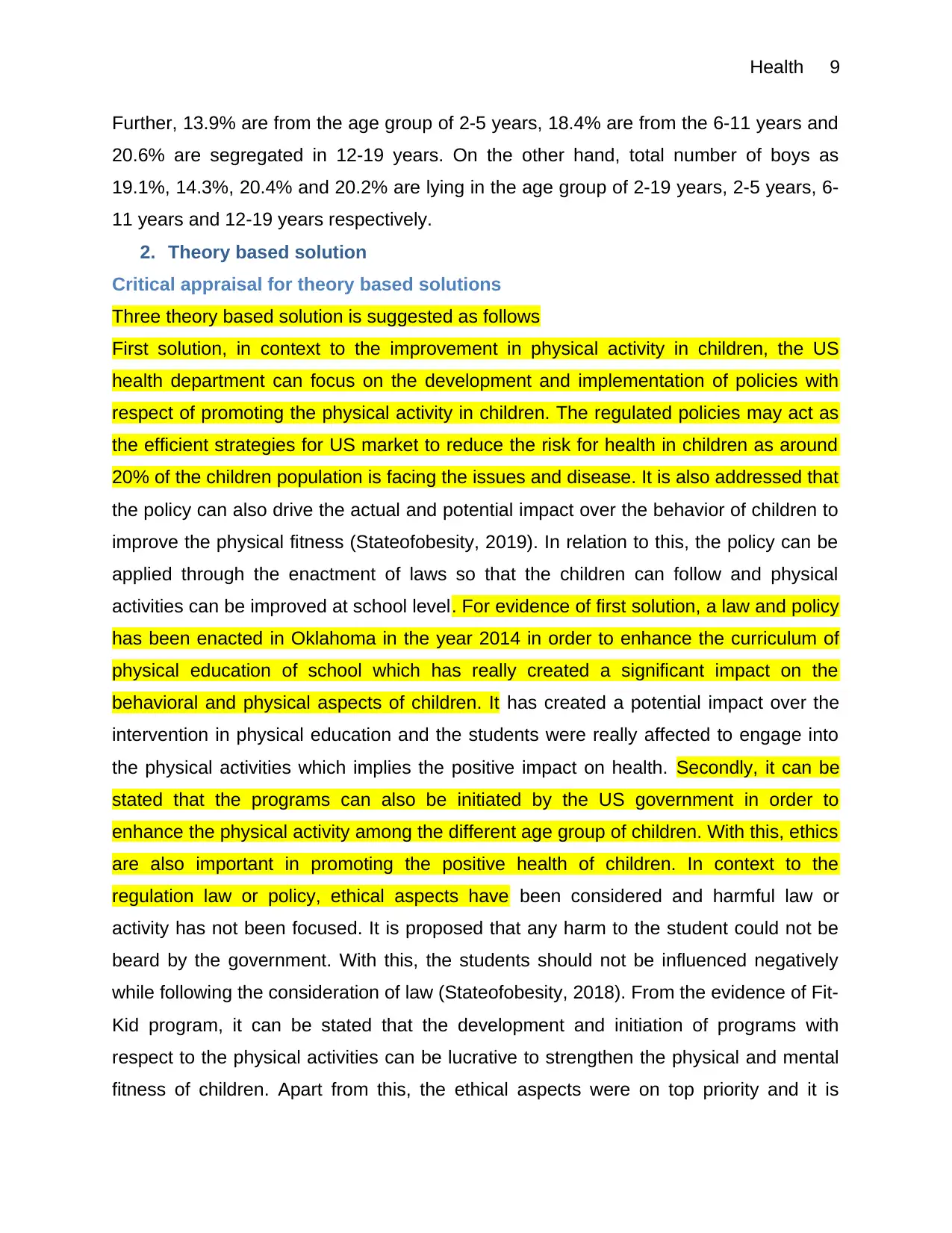
Health 9
Further, 13.9% are from the age group of 2-5 years, 18.4% are from the 6-11 years and
20.6% are segregated in 12-19 years. On the other hand, total number of boys as
19.1%, 14.3%, 20.4% and 20.2% are lying in the age group of 2-19 years, 2-5 years, 6-
11 years and 12-19 years respectively.
2. Theory based solution
Critical appraisal for theory based solutions
Three theory based solution is suggested as follows
First solution, in context to the improvement in physical activity in children, the US
health department can focus on the development and implementation of policies with
respect of promoting the physical activity in children. The regulated policies may act as
the efficient strategies for US market to reduce the risk for health in children as around
20% of the children population is facing the issues and disease. It is also addressed that
the policy can also drive the actual and potential impact over the behavior of children to
improve the physical fitness (Stateofobesity, 2019). In relation to this, the policy can be
applied through the enactment of laws so that the children can follow and physical
activities can be improved at school level. For evidence of first solution, a law and policy
has been enacted in Oklahoma in the year 2014 in order to enhance the curriculum of
physical education of school which has really created a significant impact on the
behavioral and physical aspects of children. It has created a potential impact over the
intervention in physical education and the students were really affected to engage into
the physical activities which implies the positive impact on health. Secondly, it can be
stated that the programs can also be initiated by the US government in order to
enhance the physical activity among the different age group of children. With this, ethics
are also important in promoting the positive health of children. In context to the
regulation law or policy, ethical aspects have been considered and harmful law or
activity has not been focused. It is proposed that any harm to the student could not be
beard by the government. With this, the students should not be influenced negatively
while following the consideration of law (Stateofobesity, 2018). From the evidence of Fit-
Kid program, it can be stated that the development and initiation of programs with
respect to the physical activities can be lucrative to strengthen the physical and mental
fitness of children. Apart from this, the ethical aspects were on top priority and it is
Further, 13.9% are from the age group of 2-5 years, 18.4% are from the 6-11 years and
20.6% are segregated in 12-19 years. On the other hand, total number of boys as
19.1%, 14.3%, 20.4% and 20.2% are lying in the age group of 2-19 years, 2-5 years, 6-
11 years and 12-19 years respectively.
2. Theory based solution
Critical appraisal for theory based solutions
Three theory based solution is suggested as follows
First solution, in context to the improvement in physical activity in children, the US
health department can focus on the development and implementation of policies with
respect of promoting the physical activity in children. The regulated policies may act as
the efficient strategies for US market to reduce the risk for health in children as around
20% of the children population is facing the issues and disease. It is also addressed that
the policy can also drive the actual and potential impact over the behavior of children to
improve the physical fitness (Stateofobesity, 2019). In relation to this, the policy can be
applied through the enactment of laws so that the children can follow and physical
activities can be improved at school level. For evidence of first solution, a law and policy
has been enacted in Oklahoma in the year 2014 in order to enhance the curriculum of
physical education of school which has really created a significant impact on the
behavioral and physical aspects of children. It has created a potential impact over the
intervention in physical education and the students were really affected to engage into
the physical activities which implies the positive impact on health. Secondly, it can be
stated that the programs can also be initiated by the US government in order to
enhance the physical activity among the different age group of children. With this, ethics
are also important in promoting the positive health of children. In context to the
regulation law or policy, ethical aspects have been considered and harmful law or
activity has not been focused. It is proposed that any harm to the student could not be
beard by the government. With this, the students should not be influenced negatively
while following the consideration of law (Stateofobesity, 2018). From the evidence of Fit-
Kid program, it can be stated that the development and initiation of programs with
respect to the physical activities can be lucrative to strengthen the physical and mental
fitness of children. Apart from this, the ethical aspects were on top priority and it is
⊘ This is a preview!⊘
Do you want full access?
Subscribe today to unlock all pages.

Trusted by 1+ million students worldwide
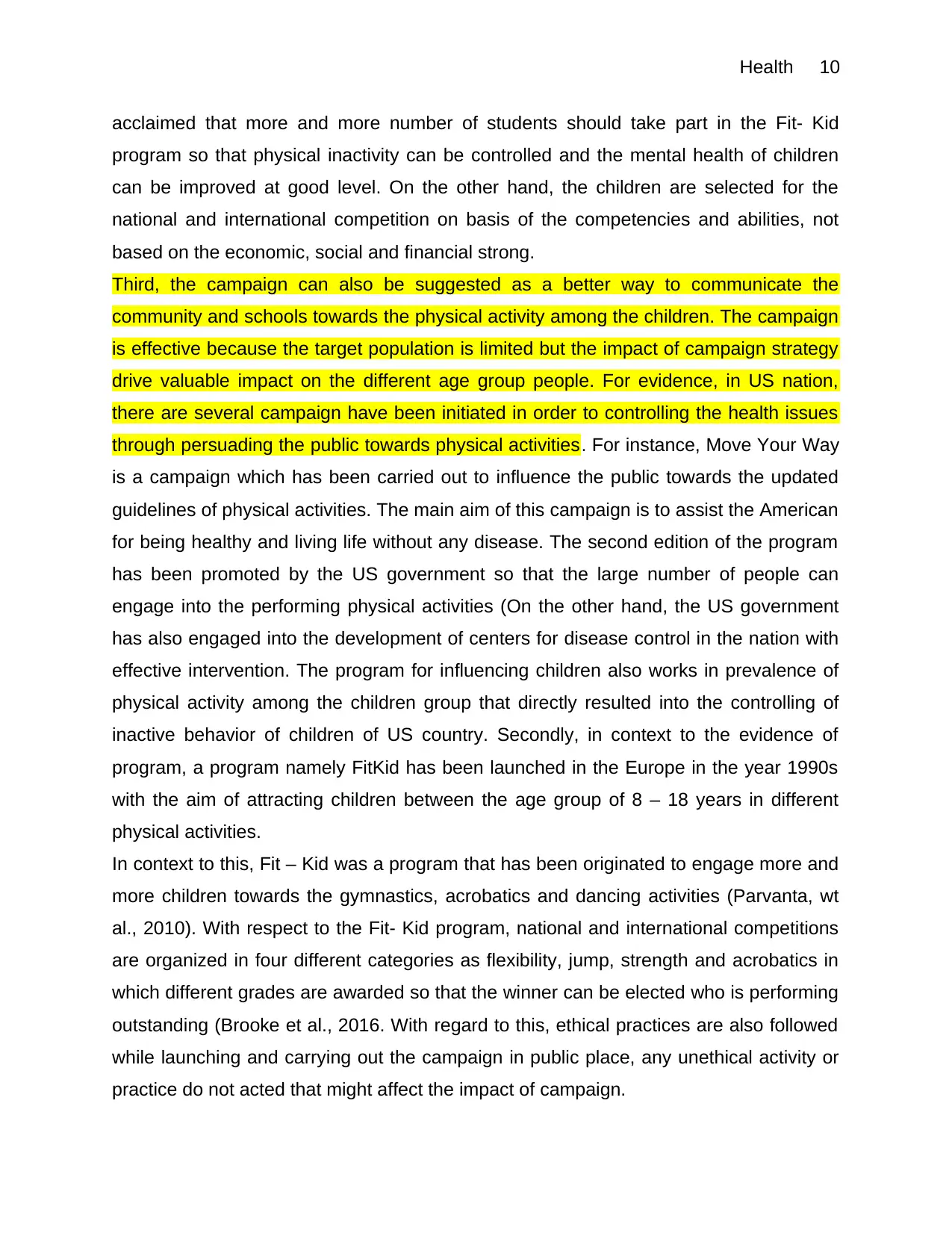
Health 10
acclaimed that more and more number of students should take part in the Fit- Kid
program so that physical inactivity can be controlled and the mental health of children
can be improved at good level. On the other hand, the children are selected for the
national and international competition on basis of the competencies and abilities, not
based on the economic, social and financial strong.
Third, the campaign can also be suggested as a better way to communicate the
community and schools towards the physical activity among the children. The campaign
is effective because the target population is limited but the impact of campaign strategy
drive valuable impact on the different age group people. For evidence, in US nation,
there are several campaign have been initiated in order to controlling the health issues
through persuading the public towards physical activities. For instance, Move Your Way
is a campaign which has been carried out to influence the public towards the updated
guidelines of physical activities. The main aim of this campaign is to assist the American
for being healthy and living life without any disease. The second edition of the program
has been promoted by the US government so that the large number of people can
engage into the performing physical activities (On the other hand, the US government
has also engaged into the development of centers for disease control in the nation with
effective intervention. The program for influencing children also works in prevalence of
physical activity among the children group that directly resulted into the controlling of
inactive behavior of children of US country. Secondly, in context to the evidence of
program, a program namely FitKid has been launched in the Europe in the year 1990s
with the aim of attracting children between the age group of 8 – 18 years in different
physical activities.
In context to this, Fit – Kid was a program that has been originated to engage more and
more children towards the gymnastics, acrobatics and dancing activities (Parvanta, wt
al., 2010). With respect to the Fit- Kid program, national and international competitions
are organized in four different categories as flexibility, jump, strength and acrobatics in
which different grades are awarded so that the winner can be elected who is performing
outstanding (Brooke et al., 2016. With regard to this, ethical practices are also followed
while launching and carrying out the campaign in public place, any unethical activity or
practice do not acted that might affect the impact of campaign.
acclaimed that more and more number of students should take part in the Fit- Kid
program so that physical inactivity can be controlled and the mental health of children
can be improved at good level. On the other hand, the children are selected for the
national and international competition on basis of the competencies and abilities, not
based on the economic, social and financial strong.
Third, the campaign can also be suggested as a better way to communicate the
community and schools towards the physical activity among the children. The campaign
is effective because the target population is limited but the impact of campaign strategy
drive valuable impact on the different age group people. For evidence, in US nation,
there are several campaign have been initiated in order to controlling the health issues
through persuading the public towards physical activities. For instance, Move Your Way
is a campaign which has been carried out to influence the public towards the updated
guidelines of physical activities. The main aim of this campaign is to assist the American
for being healthy and living life without any disease. The second edition of the program
has been promoted by the US government so that the large number of people can
engage into the performing physical activities (On the other hand, the US government
has also engaged into the development of centers for disease control in the nation with
effective intervention. The program for influencing children also works in prevalence of
physical activity among the children group that directly resulted into the controlling of
inactive behavior of children of US country. Secondly, in context to the evidence of
program, a program namely FitKid has been launched in the Europe in the year 1990s
with the aim of attracting children between the age group of 8 – 18 years in different
physical activities.
In context to this, Fit – Kid was a program that has been originated to engage more and
more children towards the gymnastics, acrobatics and dancing activities (Parvanta, wt
al., 2010). With respect to the Fit- Kid program, national and international competitions
are organized in four different categories as flexibility, jump, strength and acrobatics in
which different grades are awarded so that the winner can be elected who is performing
outstanding (Brooke et al., 2016. With regard to this, ethical practices are also followed
while launching and carrying out the campaign in public place, any unethical activity or
practice do not acted that might affect the impact of campaign.
Paraphrase This Document
Need a fresh take? Get an instant paraphrase of this document with our AI Paraphraser
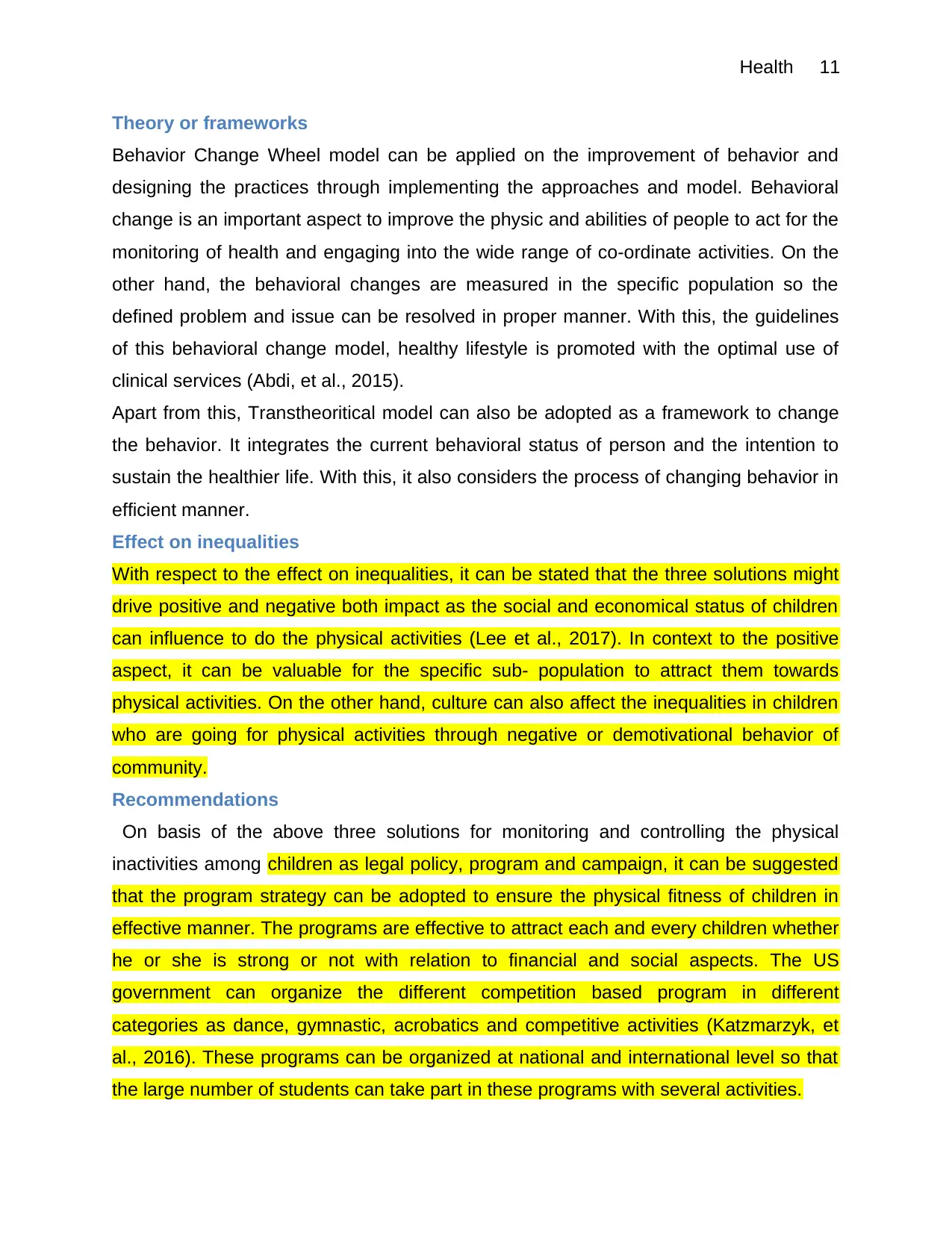
Health 11
Theory or frameworks
Behavior Change Wheel model can be applied on the improvement of behavior and
designing the practices through implementing the approaches and model. Behavioral
change is an important aspect to improve the physic and abilities of people to act for the
monitoring of health and engaging into the wide range of co-ordinate activities. On the
other hand, the behavioral changes are measured in the specific population so the
defined problem and issue can be resolved in proper manner. With this, the guidelines
of this behavioral change model, healthy lifestyle is promoted with the optimal use of
clinical services (Abdi, et al., 2015).
Apart from this, Transtheoritical model can also be adopted as a framework to change
the behavior. It integrates the current behavioral status of person and the intention to
sustain the healthier life. With this, it also considers the process of changing behavior in
efficient manner.
Effect on inequalities
With respect to the effect on inequalities, it can be stated that the three solutions might
drive positive and negative both impact as the social and economical status of children
can influence to do the physical activities (Lee et al., 2017). In context to the positive
aspect, it can be valuable for the specific sub- population to attract them towards
physical activities. On the other hand, culture can also affect the inequalities in children
who are going for physical activities through negative or demotivational behavior of
community.
Recommendations
On basis of the above three solutions for monitoring and controlling the physical
inactivities among children as legal policy, program and campaign, it can be suggested
that the program strategy can be adopted to ensure the physical fitness of children in
effective manner. The programs are effective to attract each and every children whether
he or she is strong or not with relation to financial and social aspects. The US
government can organize the different competition based program in different
categories as dance, gymnastic, acrobatics and competitive activities (Katzmarzyk, et
al., 2016). These programs can be organized at national and international level so that
the large number of students can take part in these programs with several activities.
Theory or frameworks
Behavior Change Wheel model can be applied on the improvement of behavior and
designing the practices through implementing the approaches and model. Behavioral
change is an important aspect to improve the physic and abilities of people to act for the
monitoring of health and engaging into the wide range of co-ordinate activities. On the
other hand, the behavioral changes are measured in the specific population so the
defined problem and issue can be resolved in proper manner. With this, the guidelines
of this behavioral change model, healthy lifestyle is promoted with the optimal use of
clinical services (Abdi, et al., 2015).
Apart from this, Transtheoritical model can also be adopted as a framework to change
the behavior. It integrates the current behavioral status of person and the intention to
sustain the healthier life. With this, it also considers the process of changing behavior in
efficient manner.
Effect on inequalities
With respect to the effect on inequalities, it can be stated that the three solutions might
drive positive and negative both impact as the social and economical status of children
can influence to do the physical activities (Lee et al., 2017). In context to the positive
aspect, it can be valuable for the specific sub- population to attract them towards
physical activities. On the other hand, culture can also affect the inequalities in children
who are going for physical activities through negative or demotivational behavior of
community.
Recommendations
On basis of the above three solutions for monitoring and controlling the physical
inactivities among children as legal policy, program and campaign, it can be suggested
that the program strategy can be adopted to ensure the physical fitness of children in
effective manner. The programs are effective to attract each and every children whether
he or she is strong or not with relation to financial and social aspects. The US
government can organize the different competition based program in different
categories as dance, gymnastic, acrobatics and competitive activities (Katzmarzyk, et
al., 2016). These programs can be organized at national and international level so that
the large number of students can take part in these programs with several activities.
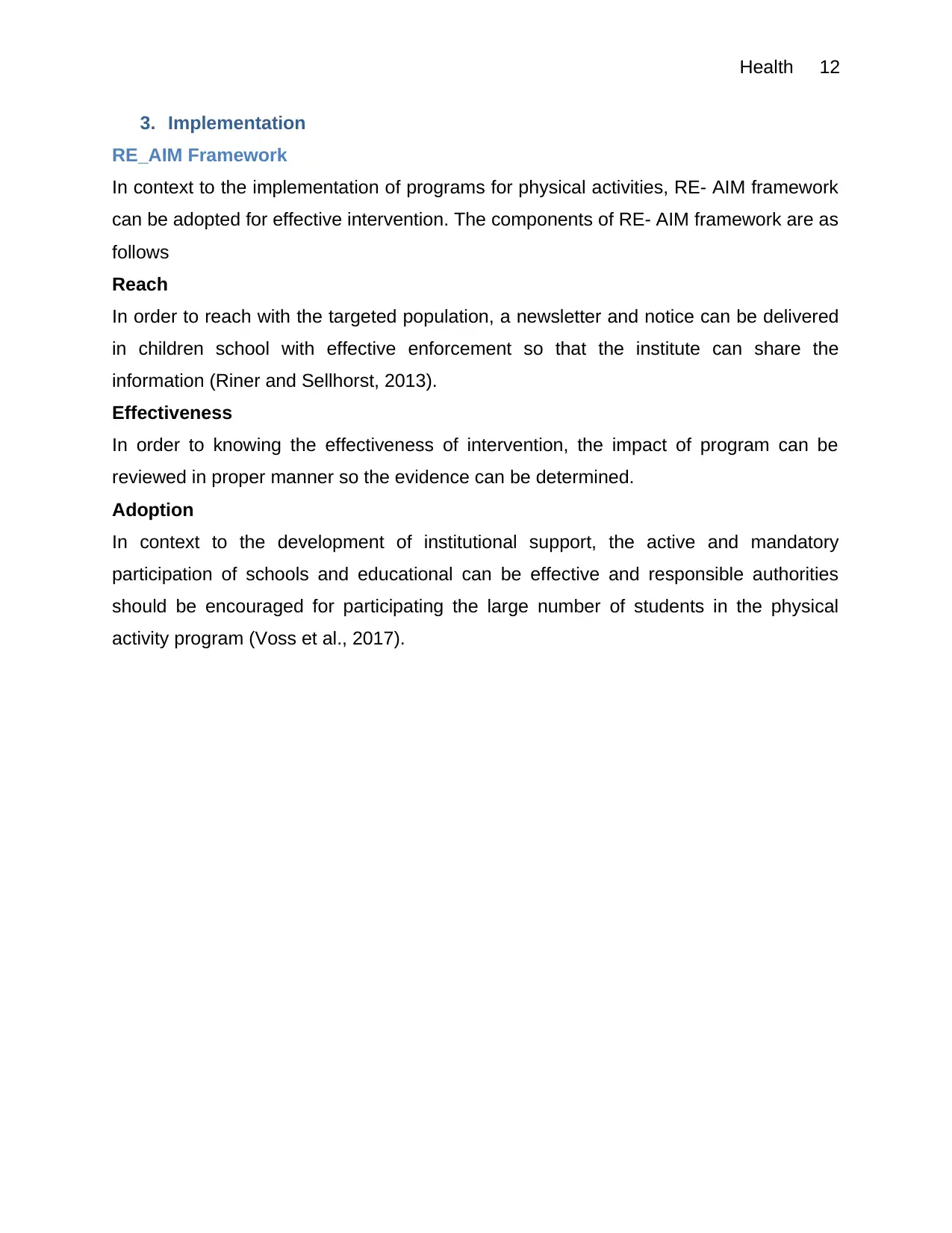
Health 12
3. Implementation
RE_AIM Framework
In context to the implementation of programs for physical activities, RE- AIM framework
can be adopted for effective intervention. The components of RE- AIM framework are as
follows
Reach
In order to reach with the targeted population, a newsletter and notice can be delivered
in children school with effective enforcement so that the institute can share the
information (Riner and Sellhorst, 2013).
Effectiveness
In order to knowing the effectiveness of intervention, the impact of program can be
reviewed in proper manner so the evidence can be determined.
Adoption
In context to the development of institutional support, the active and mandatory
participation of schools and educational can be effective and responsible authorities
should be encouraged for participating the large number of students in the physical
activity program (Voss et al., 2017).
3. Implementation
RE_AIM Framework
In context to the implementation of programs for physical activities, RE- AIM framework
can be adopted for effective intervention. The components of RE- AIM framework are as
follows
Reach
In order to reach with the targeted population, a newsletter and notice can be delivered
in children school with effective enforcement so that the institute can share the
information (Riner and Sellhorst, 2013).
Effectiveness
In order to knowing the effectiveness of intervention, the impact of program can be
reviewed in proper manner so the evidence can be determined.
Adoption
In context to the development of institutional support, the active and mandatory
participation of schools and educational can be effective and responsible authorities
should be encouraged for participating the large number of students in the physical
activity program (Voss et al., 2017).
⊘ This is a preview!⊘
Do you want full access?
Subscribe today to unlock all pages.

Trusted by 1+ million students worldwide
1 out of 18
Related Documents
Your All-in-One AI-Powered Toolkit for Academic Success.
+13062052269
info@desklib.com
Available 24*7 on WhatsApp / Email
![[object Object]](/_next/static/media/star-bottom.7253800d.svg)
Unlock your academic potential
Copyright © 2020–2025 A2Z Services. All Rights Reserved. Developed and managed by ZUCOL.





